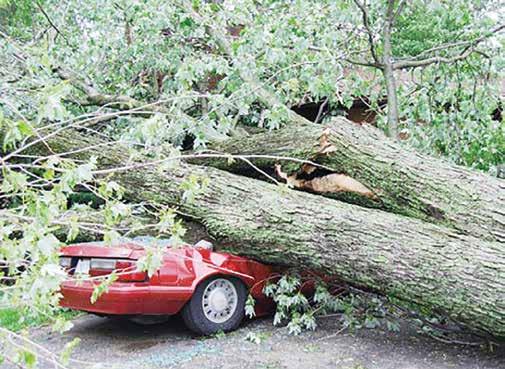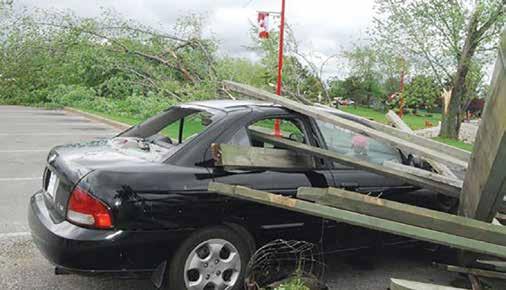
7 minute read
Memories of Tornado Still Vivid
By Mark Ribble
I was a reporter with the Leamington Post on June 6, 2010 and I got a 6am phone call from my youngest son. I was living in Tecumseh and made my way to Leamington and into the middle of the destruction. Fellow reporter Pat Bailey and I took many photos that day, some of which were published and many that were not. Some of those are on these pages.

This vehicle on Bayview took the brunt of a falling tree.
Mark Ribble photos
Ten years ago this weekend, the infamous Leamington tornado caught local residents by surprise.
The twister struck in the middle of the night and experts at the time said it was probably a good thing that most people were asleep in their beds.
The Leamington tornado was part of a large weather system that produced numerous tornadoes that weekend.
Earlier, the storm had touched down near Dundee, Michigan and, contrary to popular myth, made its way across Lake Erie. After briefly touching down near Harrow along the county’s southern shoreline, the storm skipped across Kingsville and delivered its full wrath upon Leamington’s southernmost corridor.
The devastation evident at first light along county Rd. 20 (Hwy 18) and near Seacliff Park was nothing short of a war zone.
Chuck Parsons was Leamington’s Fire Chief in 2010. The evening had been uneventful until he woke to phone calls.
“We had spent the evening celebrating Warren Dunford’s retirement,” Parsons, now the Fire Chief in Kingsville, said.

Chuck Parsons
He got the call to come in and as he headed toward the south end of town, he started to see huge trees uprooted. When he reached Bevel Line, he saw severe damage near the golf course.
“I knew we were in trouble,” he said.
Parsons made his way to the downstairs of the old Leamington Municipal Building, to activate the Emergency Response Centre.

This Mini Cooper was featured in many of the news shots of the day. It was parked in front of a residence on Park Street. Seacliff Park took a direct hit from the twister and the neighbouring streets were seriously damaged. The tornado’s path took it easterly along Seacliff Drive, causing destruction along the way. Businesses along Seacliff near the Roma Club were affected. The path went out past Gore Hill School and exited into the lake along East Beach Road.
“We’d been practicing for this event for a few years,” he said.
He called in the rest of the Emergency Response Team, including Leamington CAO Bill Marck, who lived in Kingsville.
“When Bill arrived at the Town Hall, he said he’d seen nothing to indicate a tornado,” Parsons recalls. “I said, let’s go for a ride.”

This tree was among many that were uprooted by the storm on June 6, 2010.
What they saw was like a scene from a movie. As they approached the southern end of town, it was clear this was a major disaster.
Leamington Mayor John Adams was on Pelee Island for the weekend and unable to get back. Deputy Mayor Rob Schmidt stepped in and together, they got things moving by declaring an emergency.
Over 200 homes were affected by the twister, but luckily, no serious injuries or deaths were reported.
According to Parsons, so many things had to fall into place and they did.
“We had great cooperation and help from the utilities companies, Salvation Army, Red Cross and the Leamington Police,” he said.
The years of planning paid off and Parsons was happy that everyone worked cooperatively.
“There were no egos in the room,” he said.
Although clean-up took several weeks, Parsons and his fire crew were there making sure everyone was safe immediately, coordinating the clearing of debris and checking on residents.

Erie St. South near Franklin Ave. around 7am on June 6, 2010. Residents were wandering in shock.
And thankfully the best practices and guidelines set out in the emergency plan gave them something to go on.
Parsons believes that the challenges presented by having the Emergency Operations Centre in the basement of the old town hall, helped shape thenew modern operations centre they currently have at the new town hall.
He’s grateful to his crew, the town and local police and EMS for all of their help during the weeks thatfollowed. He’s also grateful to the community as a whole.
Major Corey Vincent, who is now with the Salvation Army in Sydney, Nova Scotia, was Captain Corey Vincent at the Leamington Salvation Army when the tornado hit in 2010.
He and his family had only been in Leamington for just under a year when he faced the biggest challenge of his career on June 6, 2010.
“My wife and I had gathered the kids earlier that night and brought them to the basement,” he said. “Then we finally went to bed.”
He was also awakened by a phone call, which was someone asking if there would be church that morning.
“I said of course there will be church. Why wouldn’t there be?” he said.
The caller pointed out that much of southern Leamington had been destroyed by a tornado.
Businesses, homes destroyed, but community came together
Vincent jumped into action and went into emergency response mode.
“I parked my van on Seacliff Drive and just looked around,” he said. “I can only describe it as a war zone.”
What struck him most was an elderly gentleman calmly sweeping his driveway off in the midst of all the chaos.
“That left an impact,” he said.
Vincent and his Salvation Army crew spent the next several days making sure first responders and clean up crews were hydrated and nourished.

Leamington Municipal Marina sustained heavy damage, including this parked vehicle.
“Everyone worked together,” he recalls.
His best memory is the generosity and determination of the community. Salvation Army received a $30,000 donation from a fundraiser held for the tornado.
He’s now in his fourth year in Sydney and says the Leamington tornado experience has helped prepare him for three natural disasters he has faced since arriving on the east coast.
As for his family, he says, “We miss Leamington every single day.”
——————
For Rob Bigley, the current General Manager of Keepsake Plants Canada, the memories are much the same.

Greenhouses at Peleeview Farms on Mersea Rd. 1 (Seacliff Dr. East) were toppled.
Ten years ago, Bigley was the Head of Operations at the farm, then known as Yoder Canada. The tornado came ashore just behind their property on County Rd. 20 (Highway 18).
Bigley and Keepsake Canada’s Director of Sales, Tracy Wiper, were both present for the aftermath of Leamington’s tornado, which wiped out Plant 1 and Plant 2 at the farm along the lake.
“The call came in around 4 am to come to the farm,” said Bigley. “I looked outside from my house and the weather looked fine.”
He jumped in his vehicle and proceeded toward the farm, when he was stopped at the top of Fraser Road by Leamington Police. He explained that he’d been summoned to the farm and they let him through.
“My immediate reaction was shock,” he said. “It was like something from a sci-fi movie.”

Early damage photo at Yoder Canada on Seacliff Drive. Plants 1 and 2 were wiped out.
Submitted photo
The entire greenhouse operation was in shambles.
Bigley was concerned for his overnight boiler man, and found him huddled against a concrete wall in obvious shock, but otherwise okay. Wiper arrived shortly after and surveyed the damage. “It was like a war zone,” he said. Yoder Canada lost about $8 million in assets that day, but it could have been much higher.
“Thank goodness Mother’s Day had passed,” said Bigley. “The greenhouses were mostly empty except for our weekly plants.”
If the storm had occurred before Mother’s Day, their entire crop would have been wiped out.
As it was, the glass that embedded in the ground and in nearby homes, took years to clean up. There was glass embedded in the bricks on neighbouring houses. An outside company had to be called in to remove glass from the soil.
Bigley was quick to applaud local greenhouse growers John and Bob Ondejko at Seacliff Farms, who offered their greenhouses to them.
“They got us through the poinsettia season that year,” said Bigley.
Yoder Canada started in business in 1920 and the Plant 1 greenhouses were erected in the early 1950s, with Plant 2 coming along around 1999. Both were destroyed on June 6, 2010.

On Friday, May 29, 2020, Tracy Wiper, left, and Rob Bigley, stand in front of the open field where Plants 1 and 2 at Yoder Canada once stood. The gap in trees along the lake is the spot where they believe the tornado made landfall at about 3:10 am on June 6, 2010. Yoder Canada, now known as Keepsake Plants, lost about $8 million in property. Sun photo
Plants 3 and 4, located further east, did not sustain any significant damage
Bigley says the company employees came toghther and offered to help get the clean-up done. “It brought a tear to my eye,” he said. Within months, Bigley became General Manager and the company changed names to Keepsake Plants.
Initially, they planned to rebuild the lost greenhouses but after a few years of planning, decided to develop ther empty land, which is now being divided into 13 residential lots.







